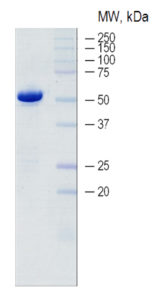SDS-PAGE: Protein was analysed in 12.5% SDS-PAGE with Coomassie blue staining.
Plasmodium Vivax LDH Protein
Price range: $1,101.47 through $3,306.53 excl. VAT
This product is a recombinant LDH protein expressed and purified from E. coli with greater than 95% purity and can be used for developing ELISA and rapid test assays.
PLASMODIUM VIVAX LDH PROTEIN
Plasmodium vivax LDH Protein is a recombinant Plasmodium vivax LDH protein expressed and purified from E. coli. Plasmodium vivax specific lactate dehydrogenase enzyme is an essential Plasmodium protein and it is expressed during the intra-erythrocytic stages of the parasitic life cycle. As such, it is used as a diagnostic marker for the detection of P. vivax malaria.
PRODUCT DETAILS – PLASMODIUM VIVAX LDH PROTEIN
- Pan Plasmodium aldolase antigen, composed of the full length of the amino acid sequence of the P. falciparum aldolase (NCBI Accession Number: DQ198262.1) which was expressed and purified from E. coli.
- Expressed in E. coli and purified by affinity chromatography. Migrates at ~66 kDa on SDS-PAGE and pI is 6.82.
- Presented in 10 mM Tris-HCl, pH 8.5, 10 mM NaCl.
- Can be used for immunoassay development.
BACKGROUND
The LDH enzyme catalyzes the interconversion of pyruvate to lactate in the final step of glycolysis, which is required for energy production in living Plasmodium cells. Ferriprotoporphyrin IX (also known as hematin) is one of the products of hemoglobin degradation by malarial parasites and intoxicates the parasite by competing with NADH for the active site of LDH. Parasite survival therefore depends on the polymerization of hematin to hemozoin, which remains active in the food vacuole of the parasite and leads to parasite death (Penna-Coutinho et al., 2011).
Plasmodium LDH is a potential diagnostic target, because of its indispensable role in endoerythrocytic stage of Plasmodia parasites (Keluksar et al., 2014) and the ldh gene shows a high degree of genetic conservation (Shin et al., 2013). As Plasmodia are also dependent on LDH for glycolytic energy production, it is also a candidate for anti-malarial therapeutics.
Plasmodium falciparum is a unicellular protozoan parasite of humans, and causes the most dangerous form of malaria, with the highest rate of complications and mortality in humans. It is transmitted through the bite of female Anopheles mosquitos and is responsible for ~50% of all malaria cases worldwide. As a result, P. falciparum is regarded as the deadliest parasite in humans, causing 435,000 deaths in 2017 alone (WHO).
REFERENCES
- Keluskar, P., Singh, V., Gupta, P., Ingle, S. (2014). Plasmodium falciparum and Plasmodium vivax specific lactate dehydrogenase: genetic polymorphism study from Indian isolates. Infection, Genetics and Evolution. 26.
- Penna-Coutinho, J., Cortopassi, W., Oliveria, A., Franca, T., Krettli, A. (2011). Antimalarial Activity of Potential Inhibitors of Plasmodium falciparum Lactate Dehydrogenase Enzyme Selected by Docking Studies. PLoS One.
- Shin, H., Kim, J., Lee, W., S, Y., Lee, S., Kang, Y., Lee, H. (2013). Polymorphism of the parasite lactate dehydrogenase gene from Plasmodium vivax Korean isolates. Malaria Journal. 12:166.
- World Health Organization. (2018). World Malaria Report 2018.


